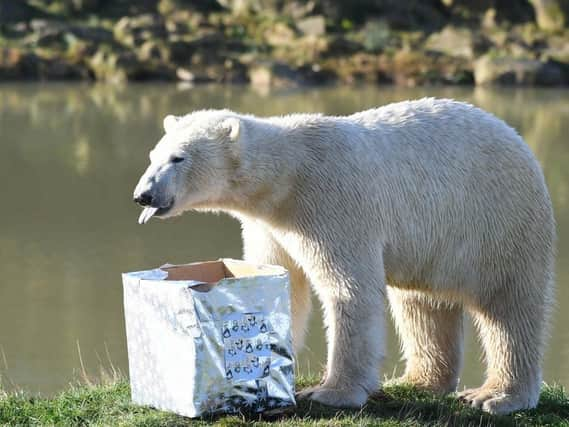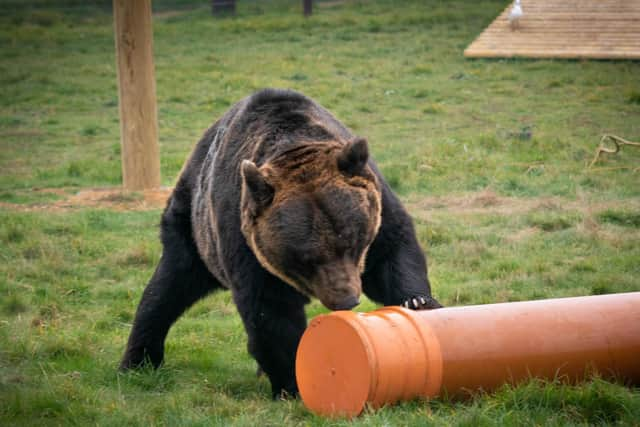A year of success for Yorkshire Wildlife Park in Doncaster


January started looking good in stripes with a celebration of International Zebra Day and the two-year anniversary of the park's Grevy Zebras. Also known as Imperial Zebras, these stunning animals are the largest of the species with thicker stripes and bigger ears than other zebras. They are the most threatened of the species with fewer than 2,500 living in the wild. They can live up to 25 years of age but poaching, habitat loss and disease have put the species on the endangered list.
In February love was in the air despite the chill as the Amur Tigers share a special moment on Valentine's Day. The endangered big cats, who hail from Siberia, showed their tender side as visitors looked on for the footbridge at Land of the Tiger reserve, one of the largest tiger exhibits in Europe. Amur Tiger numbers have dwindled to below than 500 in the wild but the park's trio are part of the European Breeding programme which is turning the tide in their favour.


Advertisement
Hide AdAdvertisement
Hide AdAs March arrived a nine-month plan came to its exciting conclusion as the park welcomed black rhinos Jasper and Makibo as part of a global breeding programme. The pair settled in swiftly after making their journey from German zoos as the world tries to protect the magnificent animals who have been so heavily poached for their horns that only 3,000 are left in the wild.
In April it was an extra special Easter as Darcey, the Bactrian camel, gave birth to a beautiful calf to add to the YWP camel family. Bactrian camels are family-oriented animals and the park's herd took to their new addition with love and pride.
New mum Darcey made sure her calf settled into her new home and took motherhood in her stride.
The good news just kept coming as in May YWP added another species to its growing family with the arrival of Ruby and Nuru, a pair of Okapi, an endangered forest giraffe. Their numbers are threatened due to logging, illegal mining and the hunting for their meat and skins in their native African Rainforest but the distinctive pair offer hope for their future.


Advertisement
Hide AdAdvertisement
Hide AdAs summer took hold in June the world-famous lions of YWP looked as breathtaking as ever during the park's Sunset Safari evening at the park when visitors got a chance to get up close and personal to the majestic animals, who were rescued by YWP from poor conditions in Romania in 2010.
The pride now lives happily, roaming their seven-acre reserve at YWP.
It was a long hot summer, but in July the summer got seriously hot, but the park's lemurs stayed cool by slurping on their very own animal-friendly ice lollies. The endangered Ring-tailed lemurs are firm favourites and impressed visitors with their ice-cool style.
As the summer months rolled on and YWP entered August three Ussuri brown bears settled into a new life after moving 6,000 miles from Japan where they were being kept in poor conditions. Riku, Kai and Hanako quickly became visitor favourites as they regained their strength and mobility thanks to the care of staff and a team of vets.
Advertisement
Hide AdAdvertisement
Hide AdIn September the Giraffe family at YWP are a happy herd and this they enjoyed themselves as they celebrated Jengo's 6th birthday. Known for his cheeky and entertaining character, Jengo is the youngest giraffe in the all-male tower of giraffes and a firm favourite with visitors. Reticulated Giraffe numbers have declined by almost 80 percent over the last 30 years.
Autumn arrived in October and World Animal Day was celebrated this month and the park's striking Amur Leopards provided an example of the need to save species around the world. These majestic animals are under severe threat of extinction with only around 60 surviving in the world. The work of YWP and other conservationists is giving them and other at risk species a chance. The Amur leopards live in Leopard Heights, a purpose-built reserve with viewing from a high tower with eye to eye views of the leopard's bespoke climbing frames, or through a large glass window.
In November a litter of rare Visayan Warty Piglets born earlier this year are settling into life at YWP. Proud mum Trish fussed over her adorable new babies who were seen running around in their new home in the woods. Their birth was an important step in the global conservation programme for the species which is on the critically endangered list after being hunted to near extinction in its native Philippines.
And so we entered December and YWP's very own Fab Four '“ Victor, Nissan, Nobby and Pixel '“ knew how to get the party started and tucked into tasty Christmas treats as festive fun jingled around the park. The visitors' favourites, live at the groundbreaking reserves of Project Polar. The park fundraises and supports vital international conservation work to save the species at risk from rapidly diminishing hunting grounds due to climate change.